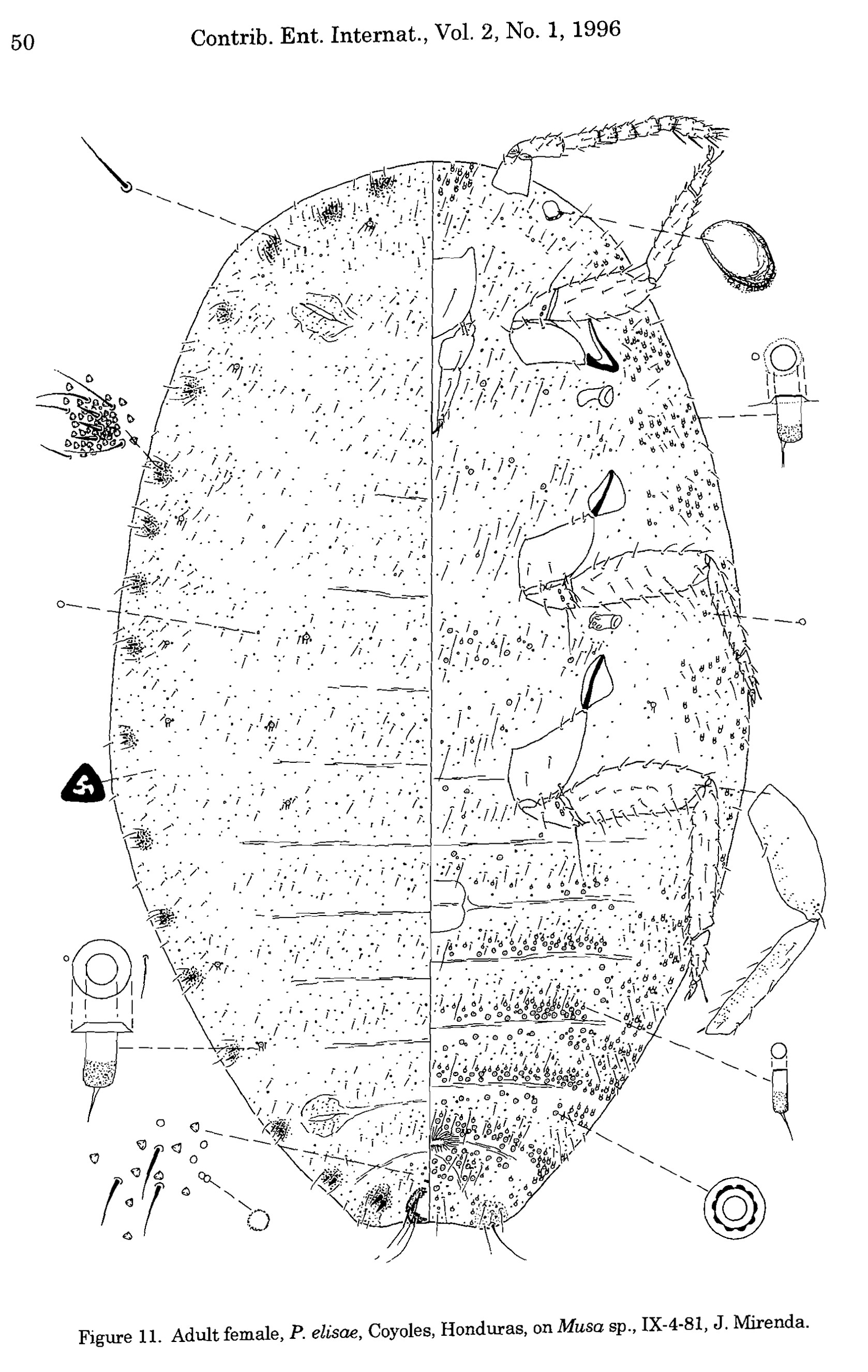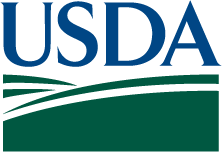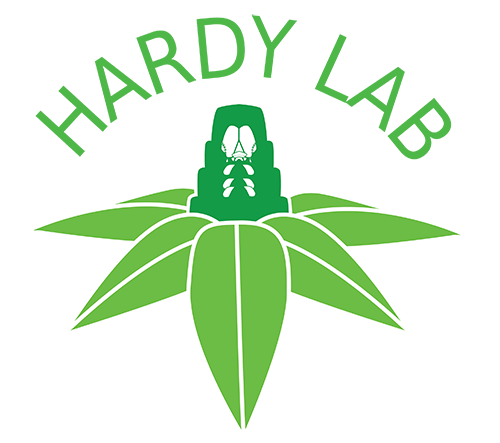Valid Names Results
Pseudococcus elisae Borchsenius, 1947 (Pseudococcidae: Pseudococcus)Nomenclatural History
- Pseudococcus elisae Borchsenius 1947b: 2110. Type data: COLOMBIA: intercepted in Russia, Leningrad, on banana spurs. Lectotype, female, by subsequent designation (GimpelMi1996,51). Type depository: St. Petersburg: Zoological Museum, Academy of Science, Russia; accepted valid name
Common Names
- banana mealybug GimpelMi1996
- Bananenschildlaus WatsonKoLa2022
- cochinilla harinosa del banano WatsonKoLa2022
Ecological Associates
Hosts:
Families: 13 | Genera: 15
- Annonaceae
- Annona squamosa | GimpelMi1996
- Apocynaceae
- Plumeria | MatileEt2006
- Araceae
- Aglaonema | GimpelMi1996
- Dieffenbachia | GimpelMi1996
- Blechnaceae
- Blechnum | GranarGo2018
- Boraginaceae
- Tournefortia polystachya | LincanHoCa2010
- Convolvulaceae
- Argyreia nervosa | MatileEt2006
- Euphorbiaceae
- Codiaeum variegatum | MatileEt2006 Mead1993
- Fabaceae
- Glycine max | MatileEt2006
- Musaceae
- Musa | Borchs1947b GimpelMi1996
- Musa paradisiaca | BenDov1994 GimpelMi1996 | (= Musa sapientum)
- Piperaceae
- Piper nigrum | CulikMaGu2006
- Rubiaceae
- Coffea arabica | GimpelMi1996 CarmonNaBe2025
- Coffea canephora | CulikMaGu2006
- Coffea liberica | GranarGo2018
- Ixora | BenDov1994 WilliaWa1988a
- Rutaceae
- Citrus aurantiifolia | BenDov1994 GimpelMi1996
- Zingiberaceae
- Alpinia | MatileEt2006
Associates:
Families: 2 | Genera: 2
- Boletinellaceae
- Phlebopus beniensis | CarmonNaBe2025
- Caulimoviridae
- BSV | PalmaJBlGu2019
- Banana Streak Virus | SisonCuPo2017
- Piper yellow mottle virus (PYMoV) | AhmedApKa2023
Geographic Distribution
Countries: 22
- Brazil
- Espirito Santo | CulikMaGu2006 CulikMaVe2007
- Chile | WatsonKoLa2022
- Colombia | BenDov1994 Borchs1947b Borchs1948d GimpelMi1996 Kondo2001
- Costa Rica | GimpelMi1996
- Cote d'Ivoire (=Ivory Coast) | WatsonKoLa2022
- Cuba | MirabaGaCa2018
- Dominican Republic | JansenAl2023
- Easter Island (=Rapa Nui) | WynneHoCo2025
- Ecuador | GimpelMi1996
- Galapagos Islands | LincanHoCa2010
- Guadeloupe | MatileEt2006
- Guatemala | GimpelMi1996
- Haiti | PerezG2008
- Hawaiian Islands | WatsonKoLa2022
- Honduras | GimpelMi1996
- Martinique | GermaiGr2005 MatileEt2006
- Panama | GimpelMi1996
- Peru | WatsonKoLa2022
- Saint Martin & St. Barthelemy
- Saint Martin | MatileEt2006
- Seychelles | WatsonKoLa2022
- Suriname | GranarGo2018
- United States
- Florida | Mead1993
- Texas | WatsonKoLa2022
Keys
- CaballKo2024: pp.8 ( Adult (F) ) [Species associated with coffee roots in Colombia]
- SzitaFeGe2023: pp.5 ( Adult (F) ) [Pseudococcidae on imported fruits in Hungary]
- Suh2019a: pp.2-6 ( Adult (F) ) [mealybugs intercepted in S. Korea]
- GranarGo2018: pp.10-14 ( Adult (F) ) [Central & South American Pseudococcus]
- LiLiWa2018: pp.538-539 ( Adult (F) ) [Species of Pseudococcus]
- VonEllWa2016: pp.77 ( Adult (F) ) [Pseudococcus species present in the New World]
- GimpelMi1996: pp.19 ( Adult (F) ) [World]
- GimpelMi1996: pp.137 ( Immature (F) ) [World]
- WilliaGr1992: pp.427 ( Adult (F) ) [Central and South America]
- Borchs1947b: pp.2110 ( Adult (F) ) [P. comstocki group of species]
Remarks
- Systematics: GenBank accesssion (Costa Rica, KP402189.1, KP402197.1, KP402194.1) Borchsenius (1948d) again referred to this species as sp. n., however, Borchsenius' (1947b) description satisfies Article 13 of the International Code, therefore the species should be dated 1947.
- Structure: The species has 17, rarely 16, pairs of thin waxy filaments that are short on the head and long on the anal lobe. The length of the body is 2.6(1.7-1.8) mm long; body length / caudal filament is 2.1(0.9-1.8). The body is lightly dusted with a white wax that does not completely conceal the pale orange body; the crushed body of the adult female is reddish brown. An ovisac is produced that is longer than or equal to the length of the body of the adult female and encloses the eggs. The species occurs on the foliage and the fruit of the host. (Gimpel & Miller, 1996) Using the SEM, it was possible to identify the presence of morphological variants of tubular ducts, those with a sclerotized oral ring, those not sclerotized and a third extended type. Different types of multilocular pores with ten lobes, those with a continuous internal opening and those with a flange on the periphery. Ostioles with an internal membranous extension.The presence of the typical circulus in between segments III and IV and an apparent second circulus in some specimens between segments IV and V. The ultrastructural characteristics observed from prior identification of the species P. elisae complements the work done with the conventional technique. (Palma-Jiménez & Blanco-Meneses, 2019)
- Economic Importance: A common, polyphagous mealybug in the Neotropical region attacking many cultivated plants. (Williams & Watson, 1988b) However, Gimpel & Miller, 1996 stated that this species was often confused with the polyphagous Pseudococcus jackbeardsleyi and, with few exceptions, is known only from banana and is restricted to the area of northern South America and Central America.
- General Remarks: Good description and illustration of the adult female given by Gimpel & Miller (1996). Good description of third instar female given by Gimpel & Miller (1996). Gimpel & Miller (1996) have shown that P. elisae has been misidentified or confused with P. jackbeardsleyi in several pre-1996 publications. Therefore, the descriptions and illustrations of the adult female - under the name P. elisae - by Beardsley (1986a), Williams & Watson (1988a), Williams & Granara de Willink (1992) and by Lit & Calilung (1994) pertain to Pseudococcus jackbeardsleyi. Caution should be exercised when using the citations given below, since many pretain mostly to P. jackbeardsleyi and only partly to P. elisae.
Illustrations
Citations
- AhmedApKa2023: virus transmission, 743
- AlfredDAsPa2020: economic importance, host, 995
- Beards1986a: description, distribution, host, illustration, taxonomy, 31-34
- BeckeAcOk2024: biological control, control,
- BeckeAcOk2024a: control, ecology,
- BenDov1994: catalog, 389
- Borchs1947b: description, distribution, host, taxonomy, 2110
- BuangAmAd2025: host, virus, 12
- CaballKo2024: key, morphology, 8
- CaballPaKa2021: distribution, 10
- CarmonNaBe2025: DNA sequencing, distribution, ecology, host,
- CulikMaGu2006: distribution, host, 1-12
- CulikMaVe2007: distribution, host, 1-5
- GermaiGr2005: distribution, host, 330
- GilCoMa2023: natural enemies, 2
- GimpelMi1996: description, distribution, host, illustration, taxonomy, 49-53, 137-139
- GranarGo2018: diagnosis, distribution, host, illustration, key, 4-14, 28
- JansenAl2023: dispersal, host, 30
- KaydanCaUl2013: economic importance, 169
- Kondo2001: distribution, host, taxonomy, 37
- KondoWa2022a: distribution, host, list, 25
- LincanHoCa2010: distribution, host, 6
- LitCa1994: description, distribution, host, illustration, taxonomy, 258-259, 264
- LitCaVi1990: distribution, host, 707
- MardinSaMi2025: host, 201
- MatileEt2006: distribution, host, 182
- Mead1993: distribution, host,
- Meurge2011: distribution, 82
- MirabaGaCa2018: distribution, host, 194-195
- PalmaJBl2016: distribution, host, phylogeny, 126-128, 130-131
- PalmaJBl2017: molecular biology,
- PalmaJBl2018: SEM, morphology, taxonomy,
- PalmaJBlGu2019: biology, distribution, economic importance, host, taxonomy,
- PerezG2008: distribution, 217
- PoornaSiMu2025: control, distribution, host, 13
- RohimaRaSa2024: diagnosis, 304
- RosadeMo2021: distribution, host,
- SagarrViSt2001a: biological control, 112-116
- SchneiLa2020: ant association, 288
- SisonCuPo2017: virus transmission, 203-214
- Suh2019a: key, 3
- SzitaFeGe2023: key, 5
- WatsonKoLa2022: biological control, biology, control, diagnosis, distribution, host, illustration, natural enemies, 196-197
- Willia1986c: distribution, host, taxonomy, 53
- WilliaGr1992: description, distribution, host, illustration, taxonomy, 440-443
- WilliaMa2012: distribution, host, 90
- WilliaWa1988a: description, distribution, host, illustration, taxonomy, 181-183
- WynneHoCo2025: distribution, list of species, 19




